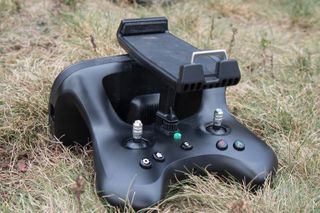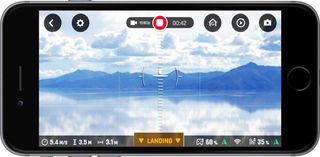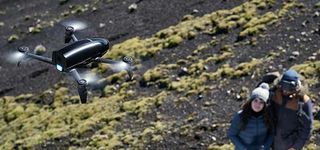Parrot Bebop 2 Power FPV Pack Drone Review: Best Simple Video Drone
The Parrot Bebop 2 Power FPV pack offers a lot of features for moviemakers, but no 4K video.
Why you can trust Tom's Guide

The latest version of the Parrot Bebop drone is the Bebop 2 Power FPV Pack, a version that offers all the functions an aspiring drone pilot would want at a fairly reasonable $599. Throw in a smartphone and you've got a first-person-view (FPV) drone that is fast and fun to fly and can take great-quality video and photos.
Design
The Bebop 2 Power has the same lightweight construction as older models of the Bebop 2, with lightweight plastic and foam forming most of the body. With the battery installed, the Bebop 2 Power weighs in at a svelte 1.15 pounds. Despite the lightweight construction, it is a pretty tough drone: It stood up to a number of crashes and hard landings without a problem. Two 3350 mAh batteries are included in this package, which provide a combined 20-30 minutes of flight time.

The Skycontroller 2 controller is a rather unusual design. For the most part, it looks like a typical video game controller, but it has a large flat panel on the top; this contains the antenna that connects the drone to the controller.

This does make it a little larger than most drone controllers, but it isn't heavy and is small enough to fit into a moderately sized bag or case. Parrot offers a small $99 backpack designed to carry the drone, controller and FPV headset on a hike. The combination of drone and controller is much bigger than the DJI Mavic Pro, though, and will take up much more valuable space in a backpack on a trip.

Your smartphone fits onto a clamp on the top of the controller, which can hold anything from a small phone to an iPad, including an iPad mini (the iPad Pro won’t fit, though). The device connects to the controller over a USB connection, and cables for micro USB and lightning port are included. When the cable is plugged in, it starts up the FreeFlight app.
MORE: The Best Drones and Quadcopters on Any Budget
There are a good number of buttons on the controller. They access settings in the FreeFlight app, return the drone to home, takeoff and start video or take photos. In addition, a shoulder dial controls the tilt of the camera.

The FPV headset is one of the best I've tested. Most are made of rigid plastic, but this one is made of soft silicone that folds down almost flat for storage. That not only makes it smaller to carry, but also more comfortable to wear. It fits comfortably over glasses - a definite plus for aging pilots like me.

The headset doesn't have its own display; rather, you have to launch the Parrot Freeflight app on your smartphone, and then insert it into the goggles. A Samsung Note 8 fit easily into the headset once I removed the phone's case. The only problem I found was that my Note 8 had a habit of slipping down slightly in the case, ruining the alignment of the images. This was solved with the addition of a piece of wood to hold the phone in place.

Controls
The Skycontroller 2 is easy to use, although its small grips mean you have to keep a tight hold, and the big antenna and position of the smartphone makes it a little unbalanced. The control sticks fall naturally under the thumbs, and the shoulder buttons and dials fall naturally under the index finger.
In Flight
The Bebop 2 has two flight modes: video and sport. In the video mode, the drone focuses on smooth, level flight, responding slowly to the controls and turning or moving at moderate speed. Switch to sport mode, though, and the Bebop 2 turns into a speed machine, zipping and turning significantly faster. We measured the highest speed it could manage at just under 30 mph horizontally and about 5 mph vertically.
Autonomous Flight
When flying in video mode, the Bebop 2 offers a selection of preprogrammed video shots, such as a Reveal, where the drone flies toward the target, slowly panning the camera up to reveal the target. These work pretty well, but you don't get much control over the specific details. For more control, you need to lay out $20 for the pro version of FlightPlan, which adds the ability to create custom flight plans from GPS points. Again, this is simple to use: you just pick the points, the height and orientation of the drone and the speed, and it creates the flight plan and controls the drone when you hit go.

The Parrot Bebop 2 also offers a new mode called Follow Me, where you tap on an object in the camera view, and the drone tries to follow the object as it moves, either panning and tilting to keep it in view or following the object at the same distance. I found this mode worked fairly well with distinct objects like a walking or running person, but it was unable to track my dog as he ran around. That's because the mode uses a combination of image recognition and the GPS receiver on the device running the app, and I wasn't going to give my dog the controller.
MORE: Drone Buying Guide: Everything You Need to Know
This mode also has an unusual feature called climb mode, where the drone will track the subject and also keep level with it vertically. The idea is that it can track you as you climb up a cliff, following your progress. We weren't able to test this mode fully, but we did find that the drone did a good job of tracking some vertical moves of the controller.
Photos and Video
The Bebop 2 captures excellent-quality 1080P video at 24, 25 or 30 frames per second (fps), or still images at 13 megapixels. Unlike most other drones, the camera itself does not move when you pan and tilt the view. Instead, the camera captures a fish-eye view, which the software then crops to create the recorded image. So, when the camera view tilts down, the cropped area changes rather than the camera itself moving. It sounds more complicated than gimbals, but it works very effectively. This approach also means that the camera can keep video steady as the drone itself bounces around. The sample videos on this page were taken on a day with winds gusting up to 5 mph or so, but the video remained steady, even when it encountered gusts over the tops of the trees.
There is no support for the higher-resolution 4K video that other modern drones capture,though, and the HD video is not as sharp and clean as that captured by models with more sophisticated cameras, like the DJI Phantom 4 or the Mavic Pro. Then again, those drones cost twice as much.
The images that the Bebop 2 captured were full of detail and clean, bright colors. These can be saved as JPEG or DNG images, an uncompressed file format that makes it easier to process the images later in programs such as Photoshop. You can also capture the unprocessed, 180-degree view image from the camera.
Battery Life
I found that the large 3350 mAh batteries that come with the Bebop 2 provide about 11 to 14 minutes of flight time each. As the drone comes with two batteries, that gives you between 22 and 28 minutes of flight time.
MORE: What the FAA's Drone Rules Could Mean for You
These batteries take about three-quarters of an hour to recharge with the included charger, which also charges the controller. Only one battery can be charged at a time.
Accessories
Parrot offers a good range of spare parts and accessories for the Bebop 2. A set of four new rotors costs $14.90, while a new nose costs $14.99. Spare batteries are not cheap, though: each costs $79.99.
Bottom Line
The $599 Parrot Bebop 2 Power FPV offers a lot of features for the price. You get a drone that can take great video and photos, and flying fast if you want to try racing. The FPV headset is also comfortable to use, and produces a great feeling of being in the pilot's seat. If you're looking for something more compact, the DJI Spark is a good option; its Fly More pack costs $650, and includes an extra battery and charger, but no FPV goggles.
Neither the Spark nor the Bebop 2 can record in 4K; for that, you'll want to step up to the $999 DJI Mavic Pro, which is also more portable. But for casual drone users who want the FPV experience, and to shoot HD video, the Bebop 2 is a great pick.
Credit: Parrot
Sign up to get the BEST of Tom’s Guide direct to your inbox.
Upgrade your life with a daily dose of the biggest tech news, lifestyle hacks and our curated analysis. Be the first to know about cutting-edge gadgets and the hottest deals.
Richard Baguley has been working as a technology writer and journalist since 1993. As well as contributing to Tom's Guide, he writes for Cnet, T3, Wired and many other publications.
